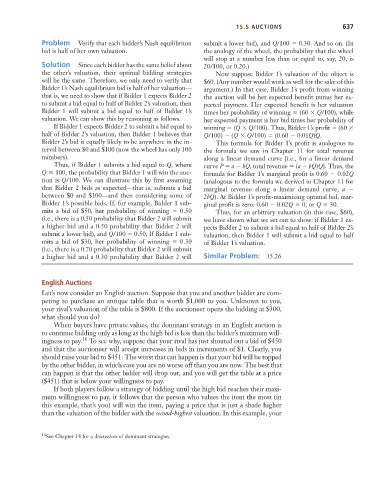Page 663 - Microeconomics, Fourth Edition
P. 663
c15riskandinformation.qxd 8/16/10 11:10 AM Page 637
15.5 AUCTIONS 637
Problem Verify that each bidder’s Nash equilibrium submit a lower bid), and Q/100 0.30. And so on. (In
bid is half of her own valuation. the analogy of the wheel, the probability that the wheel
will stop at a number less than or equal to, say, 20, is
Solution Since each bidder has the same belief about 20/100, or 0.20.)
the other’s valuation, their optimal bidding strategies Now suppose Bidder 1’s valuation of the object is
will be the same. Therefore, we only need to verify that $60. (Any number would work as well for the sake of this
Bidder 1’s Nash equilibrium bid is half of her valuation— argument.) In that case, Bidder 1’s profit from winning
that is, we need to show that if Bidder 1 expects Bidder 2 the auction will be her expected benefit minus her ex-
to submit a bid equal to half of Bidder 2’s valuation, then pected payment. Her expected benefit is her valuation
Bidder 1 will submit a bid equal to half of Bidder 1’s times her probability of winning (60 Q/100), while
valuation. We can show this by reasoning as follows. her expected payment is her bid times her probability of
If Bidder 1 expects Bidder 2 to submit a bid equal to winning (Q Q/100). Thus, Bidder 1’s profit (60
half of Bidder 2’s valuation, then Bidder 1 believes that Q/100) (Q Q/100) (0.60 0.01Q)Q.
Bidder 2’s bid is equally likely to be anywhere in the in- This formula for Bidder 1’s profit is analogous to
terval between $0 and $100 (now the wheel has only 100 the formula we saw in Chapter 11 for total revenue
numbers). along a linear demand curve [i.e., for a linear demand
Thus, if Bidder 1 submits a bid equal to Q, where curve P a bQ, total revenue (a bQ)Q]. Thus, the
Q 100, the probability that Bidder 1 will win the auc- formula for Bidder 1’s marginal profit is 0.60 0.02Q
tion is Q/100. We can illustrate this by first assuming (analogous to the formula we derived in Chapter 11 for
that Bidder 2 bids as expected—that is, submits a bid marginal revenue along a linear demand curve, a
between $0 and $100—and then considering some of 2bQ). At Bidder 1’s profit-maximizing optimal bid, mar-
Bidder 1’s possible bids. If, for example, Bidder 1 sub- ginal profit is zero: 0.60 0.02Q 0, or Q 30.
mits a bid of $50, her probability of winning 0.50 Thus, for an arbitrary valuation (in this case, $60),
(i.e., there is a 0.50 probability that Bidder 2 will submit we have shown what we set out to show: if Bidder 1 ex-
a higher bid and a 0.50 probability that Bidder 2 will pects Bidder 2 to submit a bid equal to half of Bidder 2’s
submit a lower bid), and Q/100 0.50. If Bidder 1 sub- valuation, then Bidder 1 will submit a bid equal to half
mits a bid of $30, her probability of winning 0.30 of Bidder 1’s valuation.
(i.e., there is a 0.70 probability that Bidder 2 will submit
a higher bid and a 0.30 probability that Bidder 2 will Similar Problem: 15.26
English Auctions
Let’s now consider an English auction. Suppose that you and another bidder are com-
peting to purchase an antique table that is worth $1,000 to you. Unknown to you,
your rival’s valuation of the table is $800. If the auctioneer opens the bidding at $300,
what should you do?
When buyers have private values, the dominant strategy in an English auction is
to continue bidding only as long as the high bid is less than the bidder’s maximum will-
ingness to pay. 16 To see why, suppose that your rival has just shouted out a bid of $450
and that the auctioneer will accept increases in bids in increments of $1. Clearly, you
should raise your bid to $451: The worst that can happen is that your bid will be topped
by the other bidder, in which case you are no worse off than you are now. The best that
can happen is that the other bidder will drop out, and you will get the table at a price
($451) that is below your willingness to pay.
If both players follow a strategy of bidding until the high bid reaches their maxi-
mum willingness to pay, it follows that the person who values the item the most (in
this example, that’s you) will win the item, paying a price that is just a shade higher
than the valuation of the bidder with the second-highest valuation. In this example, your
16 See Chapter 14 for a discussion of dominant strategies.

